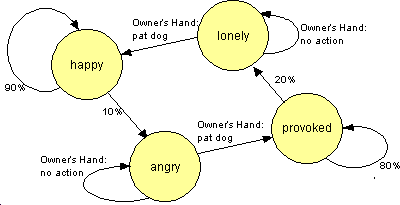Module 6, pp. 231 - 232, problems 11, 13, 15
Click here to return to top of this page.
- (9 points) Construct truth tables for P + Q', Q'+PQ, and (P'Q)'.
- (10 points) Suppose you had three inputs, say P, Q and R. Write truth tables for (P AND Q) OR R and P AND (Q OR R).
- (10 points) Using the truth tables you created above, build logic circuits for (P AND Q) OR R and P AND (Q OR R) using the Logg-o tool provided on the Analytical Engine CD. Provide screen shots of your working logic circuits.(Similar to those in the lecture notes).
Click here to return to top of this page.
In the previous assignment , you created a design for a "virtual pest". Your design consists of
- a user interface in the form of an HTML web page featuring form elements and pictures
- a finite-state machine describing
- the various states in which your pest may find itself,
- which states are directly reachable from each other state,
- "transition rules" describing what causes the system to change from one state to another.
- a behavior specification showing in more detail how the pest's state is displayed on the user interface, how the owner's actions affect the pest, etc.
For this exercise, you are to implement the user interface (often referred to as a front end) and submit a program design for the HTML/JavaScript code necessary to implement your virtual pest. NOTE: You do not need to complete implementation of the pest for this assignment; you need only specify the code that needs to be written, as described below.
USER INTERFACE:
You are to create a user interface you described in your previous assignment, as a web page consisting of at least one HTML form with at least two text boxes, two buttons, and some pictures. You must have a different picture to represent each of the different states that your pest can have. You may choose to include other form elements (pop-up menus, radio buttons, etc.) for extra credit.
You need to provide a brief written description on a separate sheet of paper that describes how the interface works. Think of this as a "user manual" for your virtual pest.
You should endeavor to match the original design as closely as possible - if you have decided to change or improve your original design, you need to describe the improvements in your user manual.
PROGRAM DESIGN:
Note that you are also to provide a preliminary program design for your virtual pest. The design must be done before you try to write the code. The program design contains the names of all functions you need to provide. It also provides verbal descriptions (not "JavaScript code") for each of the functions - what the function does, what form elements does it change values for and under what conditions?
Your program should contain a "startup" function that is invoked when the page is loaded and which sets the initial state. It should also have a "display" function that changes values of form elements as appropriate according to the state. It should have a function that investigates the current state periodically (cycling by using "setTimeout()" as explained in lecture) and makes state transitions as described in your design. It should also have a function for each button you defined, which investigates the state and makes state transitions as described in your design. Each time the state is changed, your program will call the "display" function to update the form elements as needed. For instance, for the example given with Part I, illustrated through the finite state machine and behavior table shown below, there will be the following functions:
- "Display" which shows the value of the state, changes the value of "pet action" to "Wag Tail" or "Bite" as appropriate, changes the value of "pet sound" to "Grrr..." or "Woof woof" as appropriate, and changes the pests picture to go with it's current state.
- "Initialize" which is run automatically when the program is loaded, sets the state to "happy", then calls "Display".
- "Simulate" which examines the state, generates a random number, updates the state as appropriate, then calls "Simulate" again using the "setTimeout" function.
- "Pat" which is run when the "Pat Dog" button is pressed, updates the state as appropriate, then calls "Simulate" again using the "setTimeout" function.

|
Element |
Type |
Possible values |
Meaning |
Action |
|---|---|---|---|---|
|
PetSound |
text box |
Grrr... |
state=angry |
|
|
OwnerHand |
button |
|
pat the dog |
changes state to "provoked" if angry, and to "happy" if lonely. |
|
PetAction |
text box |
Bite |
state=provoked |
|
|
|
|
|
|
|
Click here to return to top of this page.
Students wishing to earn extra credit can do so by completing as many of
the following additional tasks as desired:
- (5 points) Use AND, OR and NOT gates to construct a circuit
with two inputs, P and Q, and one output Z, that obey the following truth
table:
PQZ110101011001
- (10 points) Use AND, OR and NOT gates to construct a circuit
with three inputs, P, Q, and R, and one output Z, that obey the following
truth table:
PQRZ11111100101110000110010100100001
Click here to return to top of this page.